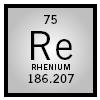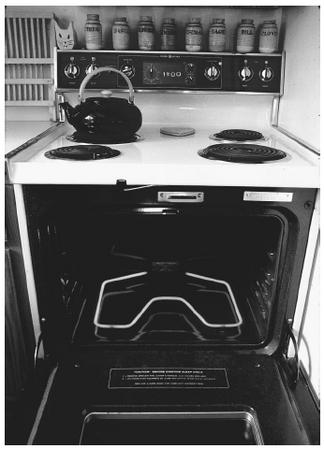Rhenium

MELTING POINT:
3,180°C
BOILING POINT:
5,627°C
DENSITY:
21.02 g/cm
3
MOST COMMON IONS:
[ReO
4
]
−
, [Re(Cl)
6
]
2−
Rhenium was discovered in a sample of gadolinite in 1925 by Walter Noddack, Ida Tacke, and Otto Berg, and was named after the Rhine River. The concentration of rhenium in Earth's crust is on the order of 7 × 10 −8 percent. Rhenium crystallizes in the hexagonal close-packed arrangement and resembles platinum in appearance. It is usually obtained as a gray powder. It has the second highest melting point (3,180°C, or 5,756°F) of any metal . Rhenium is used in conjunction with platinum in thermocouples (thermoelectric thermometers) and as a Pt/Re reforming catalyst in the petroleum industry. It is used as filaments in mass spectrometry and as furnace heater windings.
Rhenium can be prepared by the thermal decomposition of NH 4 ReO 4 or (NH 4 ) 2 ReCl 6 in the presence of H 2 , and by electrodeposition of HReO 4 from H 2 SO 4 solutions. The metal is soluble in H 2 O 2 , concentrated HNO 3 , hot H 2 SO 4 , and warm Br 2 water, but is not soluble in concentrated HF and
IDA TACKE (1896–1979)
Working with her husband and using x rays, Ida Tacke discovered element number 75, rhenium. Her birthplace, next to the Rhine River, inspired its name. Tacke is also known for predicting nuclear fission prior to its realization, although she principally studied the chemistry of light in the human eye.
—Valerie Borek

HCl. It reacts in air above 400°C (752°F) to give Re 2 O 7 . It has the widest range of valences of any element. Dissolution of Re 2 O 7 in H 2 O yields Re 2 O 3 , ReO 2 , Re 2 O 5 , ReO 3 , and the strong acid HReO 4 . With sulfur it forms Re 2 S 7 , which decomposes into ReS 2 and pure sulfur upon heating. It forms halides of stoichiometry ReX n , where n = 2 to 7 for F, 3 to 6 for Cl, 3 to 5 for Br, and 2 to 4 for I. Rhenium forms coordination compounds with alkyl, aryl, carbonyl, dinitrogen, hydrido, isocyanide, nitrido, and nitrosyl ligands , and with other ligands containing nitrogen, phosphorus, oxygen, and sulfur donors. Octahedral complexes with mixed ligands are numerous; for example, [Re(bpy)(CO) 3 (py)] = , where bpy is 2,2′-bipyridine and py is pyridine.
D. Paul Rillema
Bibliography
Cotton, F. Albert, and Wilkinson, Geoffrey (1988). Advanced Inorganic Chemistry, 5th edition. New York: Wiley.
Greenwood, N. N., and Earnshaw, A. (1984). Chemistry of the Elements. New York: Pergamon Press.
Comment about this article, ask questions, or add new information about this topic: